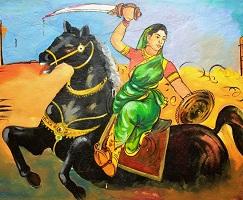Karnataka’s Syncretic Culture is being Appropriated by the Hindutva Forces
The Indian Writers' Forum participated in the Dharwad Literature Festival held on 6-7 May, 2017. The IWF Team spoke to Dr. Muzaffar Assadi, Professor of Political Science at the University of Mysore about the slow rise of communalism in Karnataka and the gradual co-option of local icons into the Hindutva fold. The aim, Professor Assadi explains, is to convert the masses into Hindus, mainly from the marginalised communities, into cultural and finally into political Hindus.
Cultural Syncretism and Tolerance
When compared to other parts of India, whether it’s Uttar Pradesh or Bihar, or Haryana and other places, Karnataka has been relatively free from communal tension and communal ideology. Karnataka remained unaffected by the Partition. It never had any memories of the Partition. In fact, memories of Partition came to Karnataka through texts or in the form of textual memories.
The first instance of communal tension can be traced back to 1920. It started on a small pretext that is the Ganesha Festival. In fact, one may recall that there is a long absence of communal tension in the history of Karnataka. The reasons were: Karnataka had a tolerant society and it celebrated cultural syncretism. Some examples of its cultural and religious syncretism are represented by the ritual practice of Naga Pantha and the influence of Sufism. As a result, this syncretic culture gave rise to a “fuzzy” community where identities were blurred.
The State was not only tolerant, it was also receptive. One remembers the Bahmani Kingdom/ Bahmani Sultanate around the Bijapur area which not only upheld Islamic tradition, they also extended their support to literature, the arts, and languages from the other princely states.
In the 1920s, a non-Brahmin movement set the stage for an affirmative action to secure reservation for marginalized groups in the princely state. Not only was there a strong alliance between communities and the State but also among the different communities. There was no division based on communal identities. Watch the interview here and read the transcript below.
Communal Ideology enters Karnataka in 1980
But in the late 1980s, the scene changed. Karnataka was on the verge of major communal shake up. Since then, certain pockets have been treated as experimental labs of the Hindutva. The coastal belt of Karnataka is the best example. What led to this transformation were the land reforms of 1970s.

Coastal belt of Karnataka/Image courtesy Wikimedia
These land reforms were progressive in nature and they provided social security to backward classes in the coastal region. They created a category of cultivators who were not landlords. Prior to this, their economy was in doldrums. They were given small patches of land. But after the land reforms, they were able to secure their own social identity. But in the 1980s this changed. There was widespread social and economic crisis. The BJP took advantage of this crisis and tried to appropriate the disillusioned lot which in turn created many fringe groups. Therefore, communal violence in the coastal belt was mainly engineered by the Hindutva groups.
The fringe groups comprised people from the Other Backward Classes. If one observes the structure of communal tension in Karnataka, three things become evident. Communal tension is primarily engineered by Hindutva groups in the coastal belt, the bashing category consists of people from the OBCs; and finally, the ideological apparatus for this was provided by the upper castes. However, this does not mean there was no backlash.
Competitive Communalism
This further gave rise to competitive communalism in the region. Islamic Fundamentalist groups such as the Popular Front of India and the Socialist Democratic Party of India (SDPI) are results of the aforesaid competitive communalism.
Any kind of dialogue between Muslims and Hindus has nearly stopped in the coastal region. Competitive communalism has also penetrated the public sphere. One sees saffron flags everywhere—in bus stands, tied to poles, rickshaws, etc. Communal tension has seeped into everyday life—one rarely sees people from these two communities get together in the coastal belt.
Communal ideology is increasingly appropriating Karnataka’s syncretic culture. Liberal spaces are shrinking in Karnataka. They are also trying to influence civil society groups and trying to mobilise and organise them.
Converting Hindus into Cultural-Political Hindus

Narayan Guru with Rabindranath Tagore in 1920/ Image courtesy RealBharat
Most importantly, political defeat is not the primary concern of communal politics in Karnataka. What is more important is the task of converting a Hindu into a cultural Hindu, especially people from the Other Backward Classes. In order to do this, they have started appropriating local symbols like Narayan Guru, Ambedkar, Rani Abbakka (the freedom fighter from a place called Ullal) and Kittur Rani Chennamma (by naming a university after her).

In fact, Hindutva forces are also slowly appropriating the corporate sector. In the malls, they supply the security guards.

Kittur Rani Chennamma/ Image courtesy navrangindia.blogspot.in
Multifaceted Fronts to Counter Communal Ideology
Who is countering this rapidly growing communal politics in Karnataka?
There are five or six groups. However, they are not strong enough to confront or counter communal politics in Karnataka. Since communal politics has penetrated everyday life practices: culture, lifestyle, texts, etc, one has to build a strong counter-culture. Strong multifaceted civil society and institutional collectives should be formed to counter communal ideology with ideas of secularism, liberalism, and freedom. Only heterogeneous, multifaceted fronts can help rebuild a tolerant and communally free Karnataka.
Disclaimer: The views expressed here are the author's personal views, and do not necessarilyrepresent the views of Newsclick
Get the latest reports & analysis with people's perspective on Protests, movements & deep analytical videos, discussions of the current affairs in your Telegram app. Subscribe to NewsClick's Telegram channel & get Real-Time updates on stories, as they get published on our website.
























